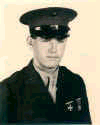"My congratulations to you personally for your part in the presentation today ... The challenge of this old but new form of operations is a real one and I know that you and the members of your command will carry on for us and the free world in a manner which is both worthy and inspiring. I am sure that the green beret will be a mark of distinction in the trying times ahead."
President John F Kennedy



"Gen. Yarborough was a living legend in the Special Forces," Retired Capt. Mike Hurst said. "He developed the airborne concept. He's the one who stood in front of President Kennedy and said 'how do you like the beret?' He's considered the father of the modern Green Beret."



Now on display is the story of Sikeston native WWII Marine, Mason Yarbrough. Yarbrough was killed on Makin Island in 1942 during a raid by the famous Carlson's Raiders. In 2000 his remains were found by a U.S. search and recovery team and returned to his family in Sikeston for a military funeral. After 58 years the footlocker of U.S. Marine Mason Yarbrough, safeguarded these many years by his family, has been again opened and is part of the display at the Sikeston Depot.

Following services at Nunnelee Funeral Chapel on December 15, 2000 he was buried at Memorial Park Cemetery in Sikeston.

Tuesday, December 12, 2000 - Marine Cpl. Brian Baksic plays taps during a ceremony at Borthwick Mortuary marking the return of the remains of Marine Cpl. Mason Yarbrough to his home in Sikeston, Mo. The remains are among those of 19 Marines killed during a raid on Makin Atoll in the Gilbert Islands 58 years ago and buried there. A team of Army anthropologists from Hawai'i found the remains and identified them. The Pentagon released the names last month.


Leesville, LA Teams competing in the Yarborough Mile were near the end of the competition when they came to the station called the “Weaver. The soldiers who were exhausted both physically and mentally were required to weave their way through the structure going over and under the poles. There were a few soldiers who lost their grip and hit either the netting or the ground. The soldiers didn't quit" they stood up, shook themselves off and tried it again.
Command Sgt. Maj. Kevin Sharkey was in the first Platoon to tackle the obstacle course.
It was his second time to participate in the competition.
Sharkey explained that the Yarborough Mile is named after Gen. William Yarborough one of the first Geronimos who went Airborne during World War II with the same battalion.
Yarborough designed the Airborne Wings along with the Gingerbread Man Patch which is worn on the uniforms of members of the 509th.
The Gingerbread Man is the image of a Jump Master standing in the door of a C-47 before he jumps. It is also called the G-Man or Geronimo, Sharkey explained.
Yarborough passed away last December, but his dedication to this Battalion continues on as his mark is evident on everything Geronimo.


USS Yarborough (DD-314) was a Clemson-class destroyer in the United States Navy during World War II. She was named for George Hampton Yarborough, Jr.
George Hampton Yarborough, Jr. (1895-1918) was an officer in the United States Marine Corps and a recipient of the Navy Cross.
Born at Roxboro, North Carolina, Yarborough enrolled in class no. 4, Marine Corps Reserve, on 7 April 1917, the day after the United States entered World War I, and was given the provisional rank of second lieutenant. After instruction at the Marine Barracks, Parris Island, South Carolina, he reported to the Marine Barracks at Philadelphia, Pennsylvania on 4 June 1917 for duty with the 16th Company, 5th Regiment of Marines. Taken to New York in Seattle (Armored Cruiser No. 11), Yarborough embarked in Henderson (Transport No. 1) on 14 June; sailed for France that day; and reached St. Nazaire on the 27th.
Yarborough, promoted to first lieutenant on 11 August 1917, served two tours of detached duty while assigned to the 5th Regiment, first at Cosne, France, between 8 December 1917 and 4 January 1918, and then at Gondrecourt, France, between 22 February and 29 April 1918.
On 23 June 1918, the height of the Battle of Belleau Wood, Lt. Yarborough arrived on the front lines. The next day, intense enemy fire from skillfully placed machine guns pinned down Yarborough's unit—a platoon in a support position in the American lines. The young lieutenant dashed from one shell hole to another, in the open, steadying his men, until a burst of machine gun fire hit him. Severely wounded, he refused aid until other wounded men in his unit received medical attention. Finally moved to shelter, he succumbed to his severe gunshot wounds on 26 June. Cited for his bravery, First Lieutenant Yarborough received the Distinguished Service Cross and Navy Cross, posthumously.


Yarboro Country Main Page
Yarboro Country 4
Yarborough Family Genealogy Forum
Yarborough Development, Inc